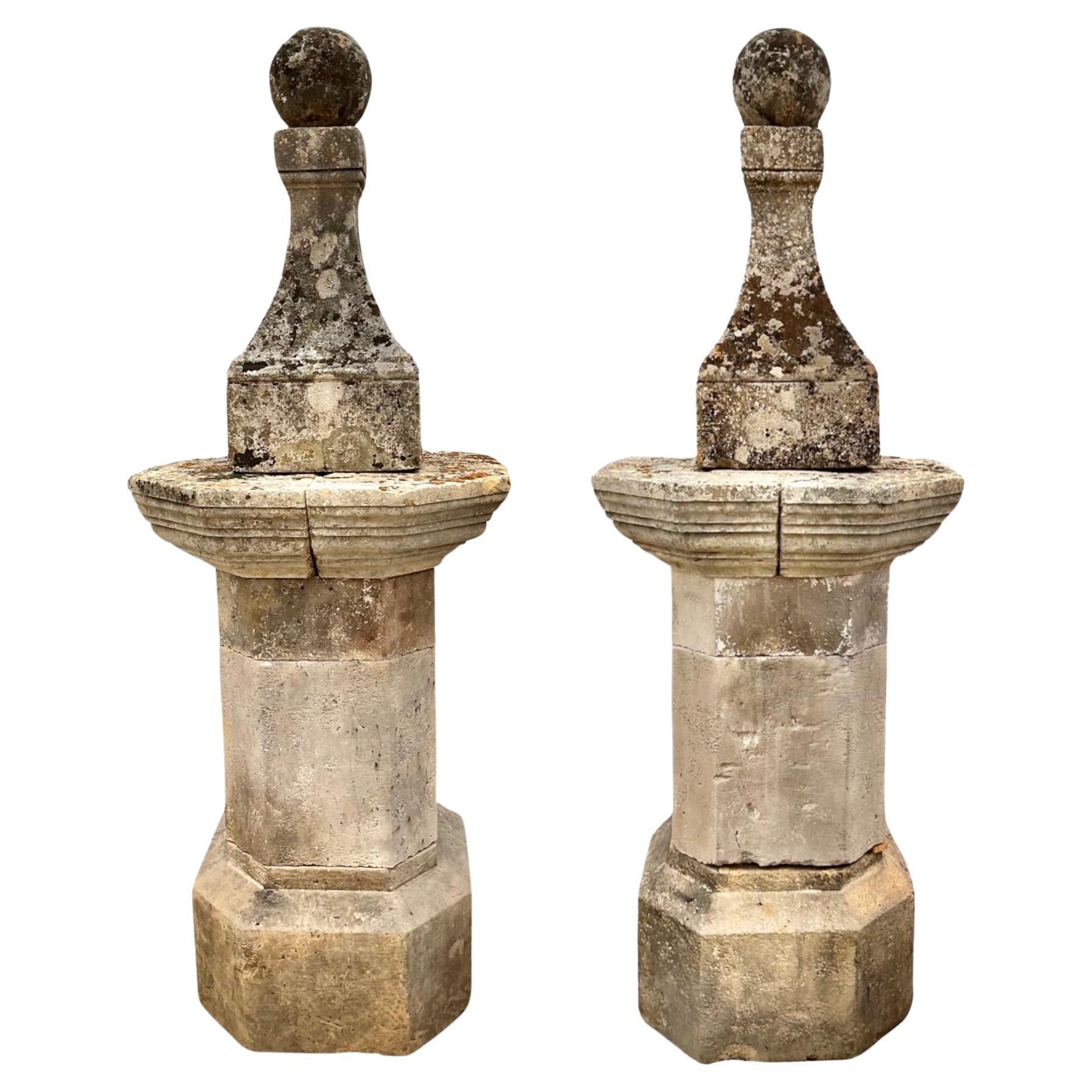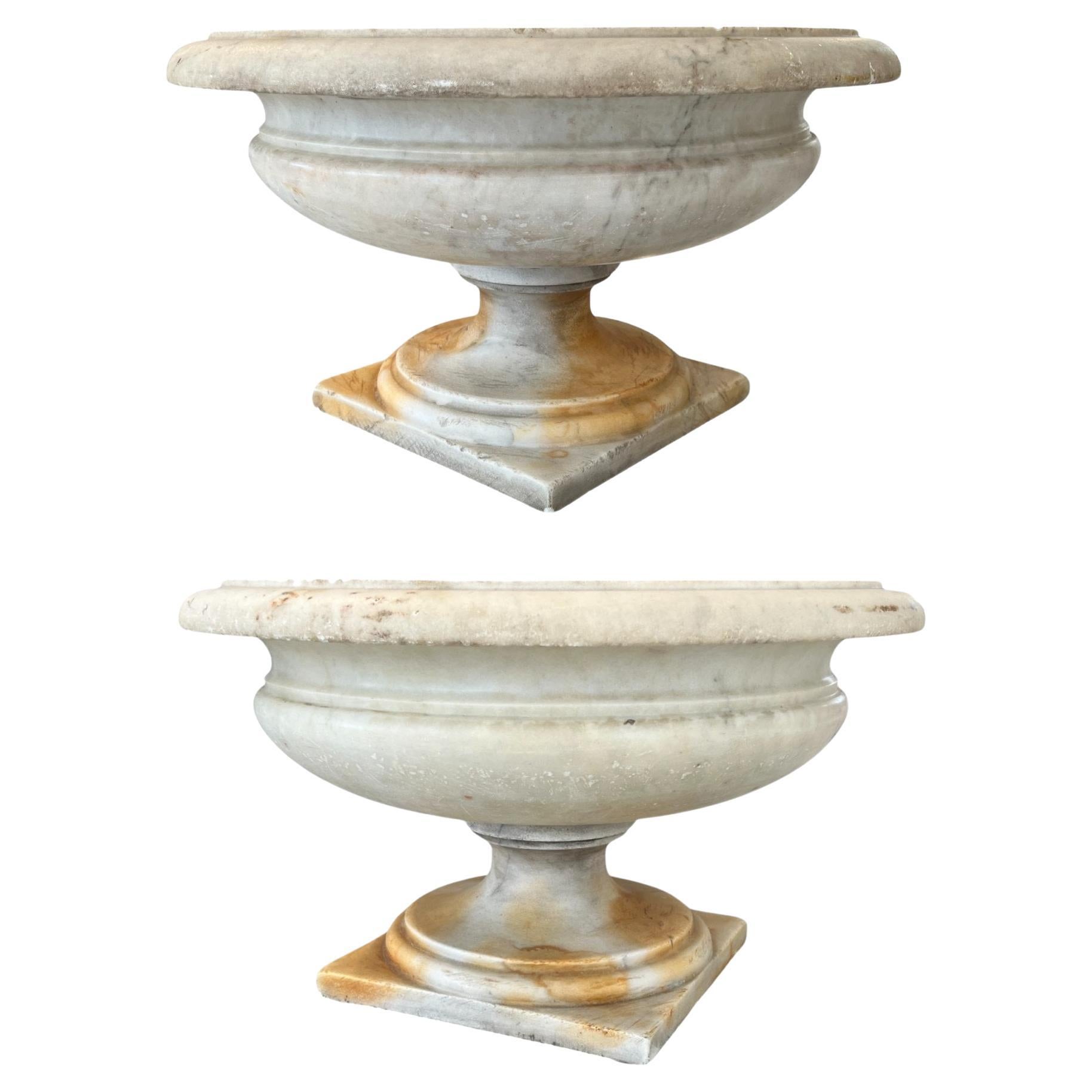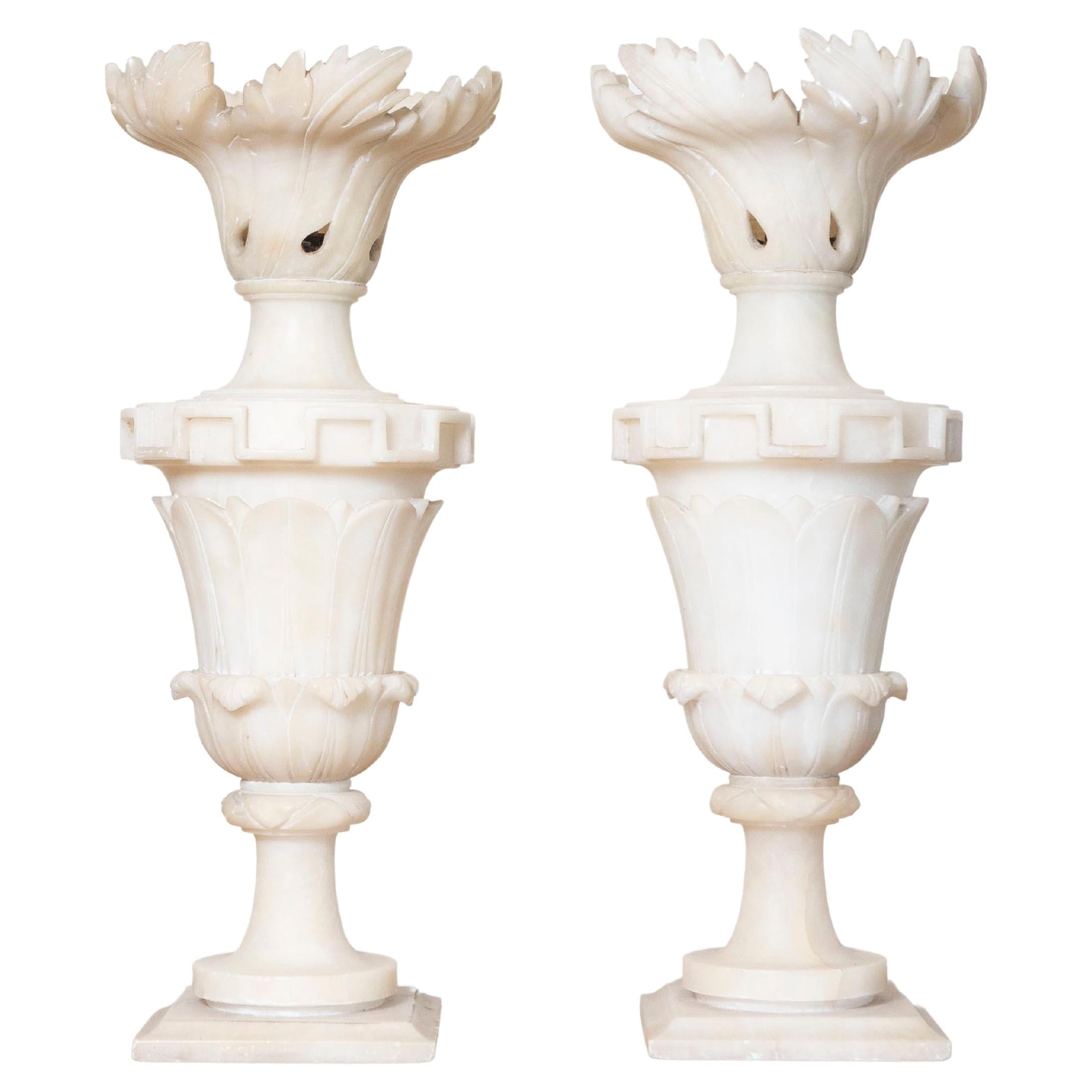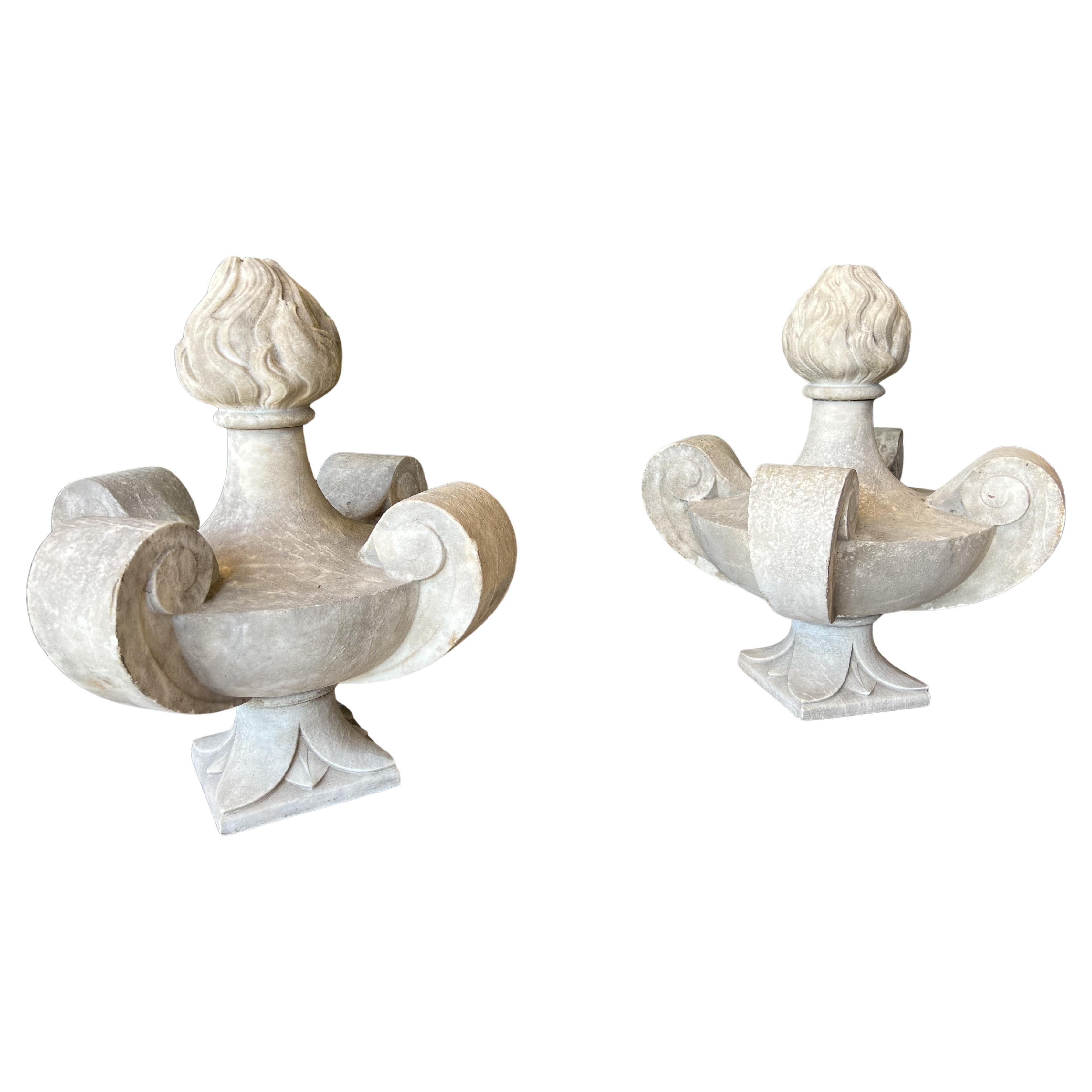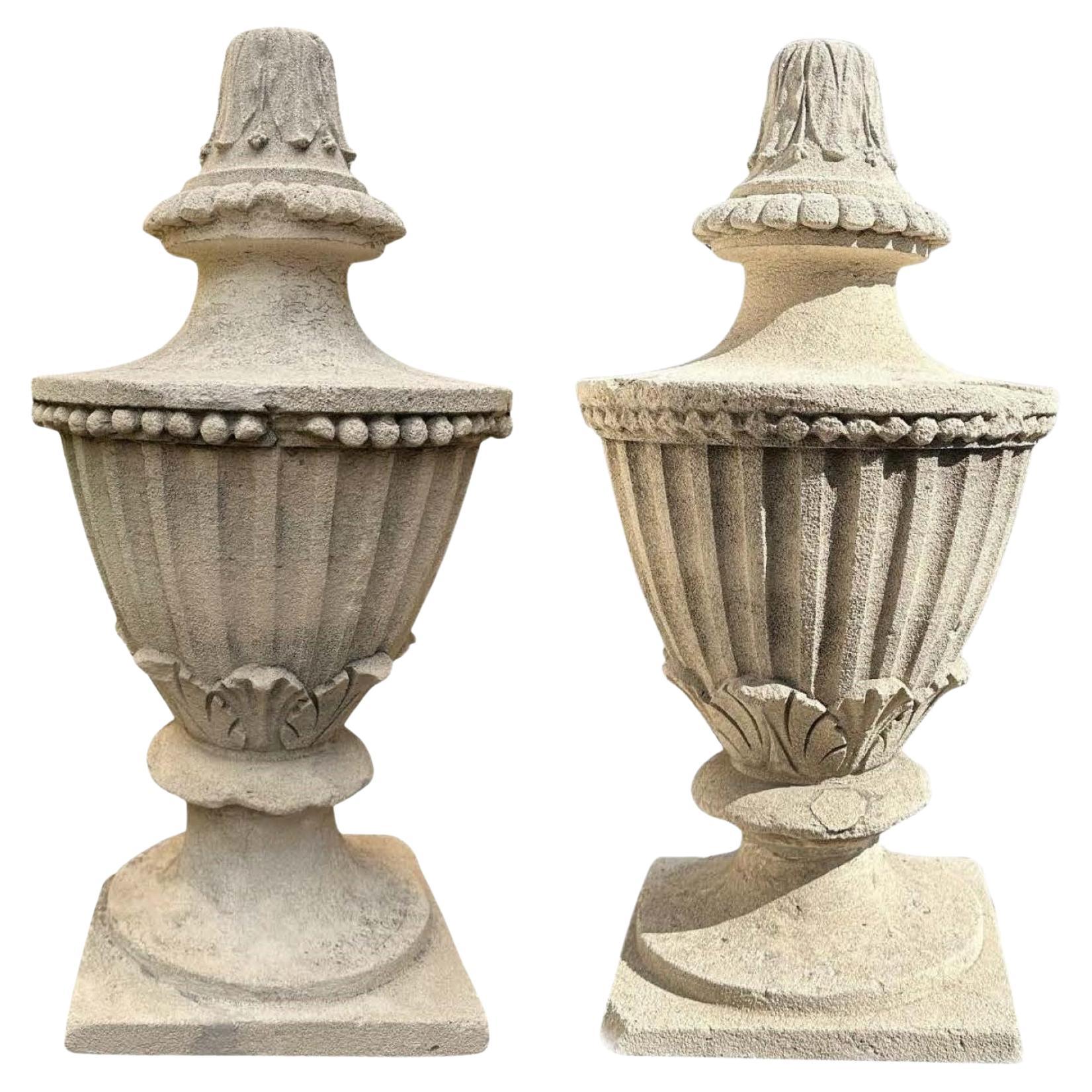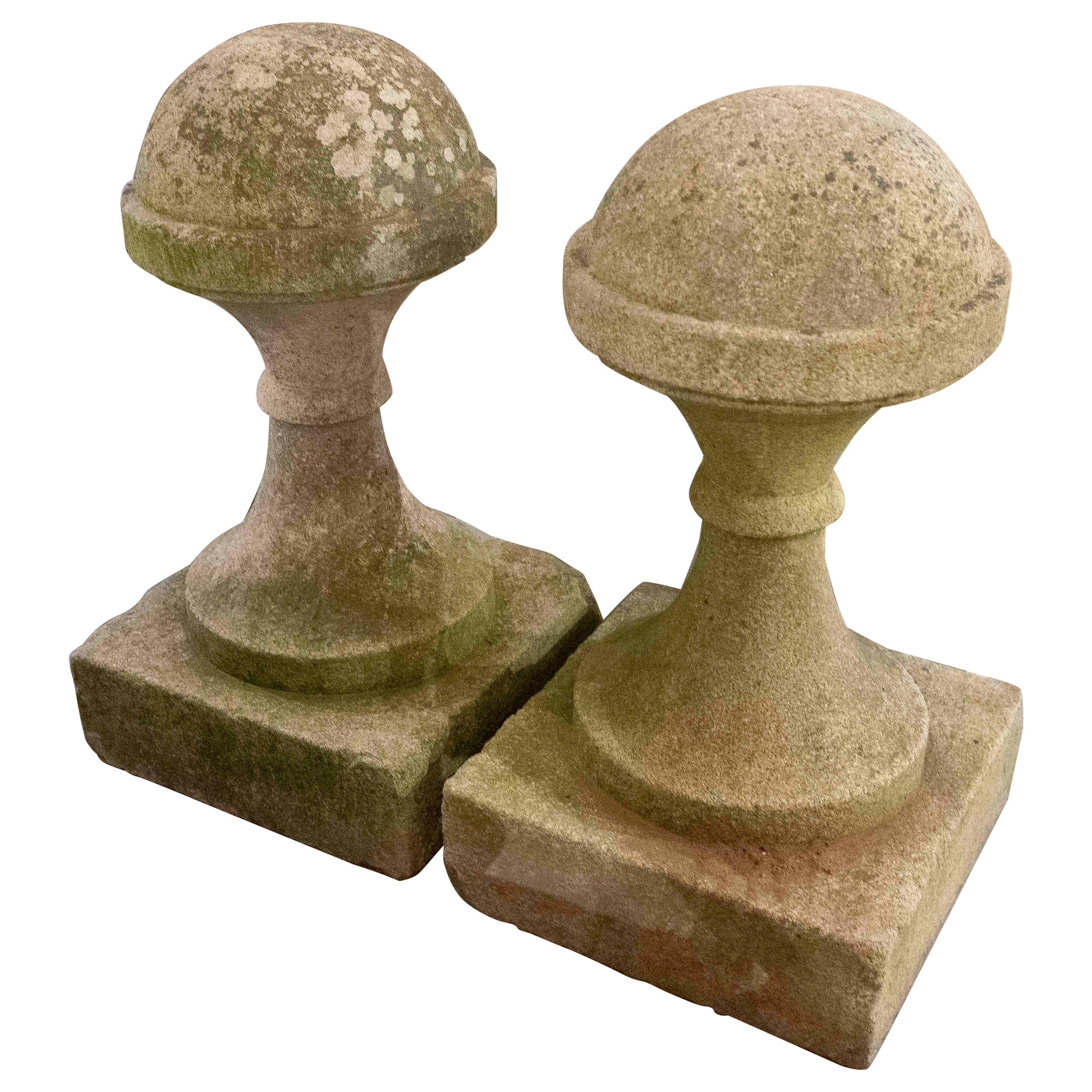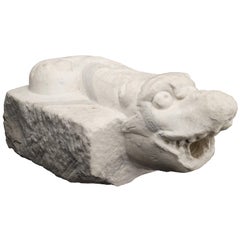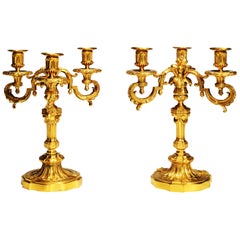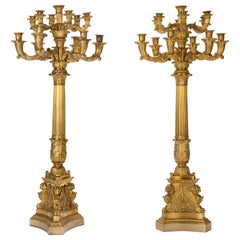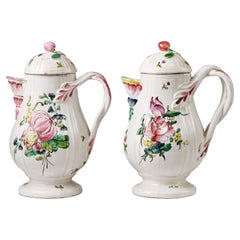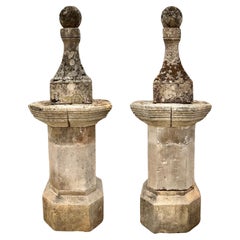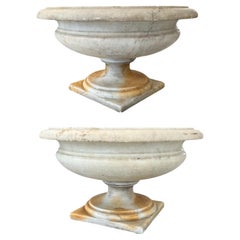Items Similar to Italian Ancient Botticino Marble Pair of Pinnacles, circa 1850
Video Loading
Want more images or videos?
Request additional images or videos from the seller
1 of 22
Italian Ancient Botticino Marble Pair of Pinnacles, circa 1850
$14,374.04per set
£10,748.55per set
€12,000per set
CA$19,803.84per set
A$21,598.87per set
CHF 11,441.62per set
MX$258,939.75per set
NOK 145,715.42per set
SEK 133,245.93per set
DKK 91,444.78per set
About the Item
Pair of pinnacles
Northern Italy, mid-19th century
Botticino marble, carved
They measure 33.1 inches in height x 17.7 x 17.7 (84 cm x 45 x 45)
State of conservation: some visible cracks and various small gaps.
The two twin architectural elements of sculpted Botticino marble have a quadrangular base from which a chalice-shaped foot extends. Resting on this, a round pod-like element swells up to support a large pine cone. This is the main decoration: however, the other ornamental details enhance and embellish it, while exalting its position above, whether observed from afar or up close.
These aesthetic characteristics suggest that originally the pair of pinnacles were placed on columns or on architectural plinths, perhaps on the sides of a gate or at the end of a staircase at a noble palace with a certain level of importance; or as a decorative element along an avenue of some garden, such as at Villa Piaggio in Genoa, where the pine cones are arranged along the park entrance.
The use of the pine cone as an architectural decoration has ancient origins and derives from the complex symbolism which, from the representation of a divinity in a broad sense, gradually takes on the more specific meaning of fertility - linked to the phallic form - and therefore of birth and rebirth after death.
Present in many ancient cultures all over the world, the pine cone is used not only in architecture, but also in other decorative areas and over time it has become an esoteric symbol linked to the pineal gland, recognized as the seat of the soul and therefore as the highest degree of spiritual enlightenment.
In this way, the architectural use of the pine cone both on the doors and along the edge of the roof or on the sides of gates and stairways of patrician villas, has an obvious auspicious meaning.
The works presented here are made of Botticino marble, a metamorphic rock from the Mesozoic era.
The quarries are located in the province of Brescia and the best-known variety of this stone comes from that of Botticino: it has a light color and characteristic organic and inorganic inclusions which determine its homogeneous, compact and low-porosity composition. All this has favored its use in the creation of decorative outdoor elements of great value, since Roman times, as the Capitolium of the city of Brescia testifies.
Although the first certain information on the extraction of this marble dates back to the end of the sixteenth century, during the Renaissance period, there is mention of the existence of "master quarrymen" as early as the end of the 15th century. In the 18th century the extraction became professional and the demand for this product increased for use in large architectural works and noble palaces.
- Dimensions:Height: 33.08 in (84 cm)Width: 17.72 in (45 cm)Depth: 17.72 in (45 cm)
- Sold As:Set of 2
- Style:Other (Of the Period)
- Materials and Techniques:
- Place of Origin:
- Period:
- Date of Manufacture:circa 1850
- Condition:Wear consistent with age and use. Some visible cracks and various small gaps.
- Seller Location:Milano, IT
- Reference Number:1stDibs: LU4352221718112
About the Seller
4.3
Vetted Professional Seller
Every seller passes strict standards for authenticity and reliability
Established in 1860
1stDibs seller since 2018
22 sales on 1stDibs
Typical response time: <1 hour
Associations
International Confederation of Art and Antique Dealers' Associations
- ShippingRetrieving quote...Shipping from: Milano, Italy
- Return Policy
More From This Seller
View AllItalian Ancient Marble Sculpture Fountain, Late 16th Century
Located in Milano, IT
Sea monster
Carrara marble mouth fountain
Italy, late 16th century
It measures 13.8 x 31.5 x 18.9 in (35 x 80 x 48 cm)
State of conservation: some small evident gaps and widespread signs of wear due to outdoor exposure. The gray marks crossing it do not come from restoration, but are rather the natural veins of the marble.
This work has some morphological characteristics typically associated with the iconography of the sea monster: an elongated muzzle, sharp teeth, protruding eyes, elongated ears, and a coiled serpent's tail.
An in-depth series of studies on artistic depictions of the sea monster attempted to verify how this symbol evolved in antiquity in the European and Mediterranean contexts and how it gradually changed its image and function over time. The iconography itself is mutable and imaginative and its history is rich with cultural and artistic exchange, as well as the overlapping of ideas. This occurred so much that it is difficult to accurately pinpoint the "types" that satisfactorily represent its various developments.
However, we can try to summarize the main figures, starting from the biblical Leviathan and the marine creature that swallowed Jonah (in the Christian version, this figure was to become a whale or a "big fish", the “ketos mega”, translation of the Hebrew “dag gadol”). Other specimens ranged from the dragons mentioned in the Iliad (which were winged and had legs) to "ketos” (also from Greek mythology), the terrifying being from whose Latinized name (“cetus”) derives the word "cetacean". See J. Boardman, “Very Like a Whale” - Classical Sea Monsters, in Monsters and Demons in the Ancient and Medieval Worlds, in Papers presented in Honor of Edith Porada, Mainz am Rhein 1987, pp. 73-84).
In Italy the monster underwent yet further variations: it can be found in Etruscan art on the front of some sarcophagi representing the companion of souls, while among the Romans we find the “Pistrice” (cited by Plinio in Naturalis Historia PLIN., Nat., II 9, 8 and by Virgilio in Eneide: VERG., Aen., III, 427), which appeared in the shape of a stylized hippocampus or a very large monstrous cetacean and evolved into a hideous being with a dragon's head and long webbed fins.
During the Middle Ages, the sea monster was the object of new transformations: at this time, it is often winged, the head is stretched like a crocodile, the front legs are often very sharp fins - sometimes real paws - until the image merges with dragons, the typical figures of medieval visionary spirituality widely found throughout Europe (on this topic and much more, see: Baltrušaitis, J., Il Medioevo fantastico. Antichità ed esotismi nell’arte gotica, Gli Adelphi 1997).
In Italy during the 15th and 16th centuries, the revival of classicism - representative of the humanistic and Renaissance periods - led to a different reading of these "creatures". Indeed, the sea monster was also to find widespread use as an isolated decorative motif, especially in numerous fountains and sculptures where dolphins or sea monsters were used as a characterizing element linked to water (on this theme see: Chet Van Duzer, Sea Monsters on Medieval and Renaissance Maps, London, The British library, 2013).
From the morphological point of view, the "sea monsters" of this period are mostly depicted as hybrid figures, in which the body of a mythological or real being (a hippocampus, a sea snake, a dolphin), is joined to a head with a rather indistinct appearance. It was usually characterized by large upright ears, an elongated snout, sharp teeth and globular, protruding eyes; a complex and indefinite figure, both from the symbolic point of view and from that of its genesis.
The work we are examining is placed as a cross between the medieval sea serpent and the Renaissance dolphin, with stylistic features which recall the snake as often used in heraldry (such as the "snake" depicted in the coat of arms of the Visconti - the lords and then dukes of Milan between 1277 and 1447 - and which, for some, may be derived from the representations of the “Pistrice” that swallowed Jonah).
In the search for sources, Renaissance cartography and in particular woodcuts should not be neglected. See for example the monsters of Olaus Magnus, from the editions of the “Historia de gentibus septentrionalibus” (“History of the peoples of the north”) and the natural histories of Conrad Gesner, Ulisse...
Category
Antique 16th Century Italian Renaissance Animal Sculptures
Materials
Carrara Marble
Pair of French Three-Flame Candelabra Candelabra, circa 1860
Located in Milano, IT
Pair of three-flame candelabra
Cast bronze, chiselled and mercury gilded
France, third quarter of the nineteenth century
Height 14.96 in (38 cm) X 12.59 (32 cm)
Weight 11.46 lb ...
Category
Antique 1860s French Napoleon III Candelabras
Materials
Bronze
19th Century Pair of French or Russian Gilt Bronze Candelabra, circa 1830
Located in Milano, IT
Pair of thirteen-flame candelabra
France or Russia
Second quarter of 19th century
Cast, chiseled and gilt bronze
Height 40.95 in (cm 104), diameter 17,7 in (cm 45)
97 lb (44 kg)
Sta...
Category
Antique 1830s French Neoclassical Candelabras
Materials
Ormolu
Ancient Pair Coffee Pots, Pasquale Rubati Manufacture Milan, 1770 circa
By Pasquale Rubati
Located in Milano, IT
Pair of small coffee pots.
Manufacture of Pasquale Rubati
Milan, 1770 Circa
Maiolica polychrome decorated “a piccolo fuoco” (third fire).
a) height 7.87 x 5.51 x 3.93 in (20 x 14 x ...
Category
Antique 1760s Italian Neoclassical Ceramics
Materials
Maiolica
Pair of Ancient Italian Maiolica Flower Pots Milan, Rubati Factory, 1770 circa
By Pasquale Rubati
Located in Milano, IT
Maiolica flower pot “a mezzaluna”
decorated with trompe l’oeil
Pasquale Rubati Factory
Milan, circa 1770
Measures: each 4.7 in (cm 12) x 5 in (c...
Category
Antique 1770s Italian Rococo Ceramics
Materials
Maiolica
Two Small Italian Dishes Antonio Maria Coppellotti Manufacture, Lodi, Circa 1740
By Antonio Maria Coppellotti
Located in Milano, IT
Two small dishes
Antonio Maria Coppellotti Manufacture
Lodi, Circa 1740
High fire polychrome majolica
They measure: diameter 7.08 in(18 cm)
Weight: 0.37 lb (170 g)
State of conservat...
Category
Antique 1740s Italian Baroque Ceramics
Materials
Maiolica
You May Also Like
Pair of French Limestone Finials
Located in Dallas, TX
Enhance your home or garden with this antique pair of French limestone finials. Crafted in the 17th century and sold as a set, these large sty...
Category
Antique 17th Century Architectural Elements
Materials
Limestone
Pair of 17th Century Tuscan Marble Jardinieres
Located in New Orleans, LA
Pair of 17th-Century Tuscan Marble Jardinieres – Exquisite hand-carved marble jardinieres featuring classical proportions and a gracefully aged patina. Their Tuscan Renaissance desig...
Category
Antique 17th Century Planters and Jardinieres
Materials
Marble
$8,988 / set
Pair of 20th Century French Alabaster Elements
Located in Atlanta, GA
This pair of 20th-century French alabaster elements features intricately designed vases, each with a classical shape and elegant detailing. The vases are crafted from alabaster, show...
Category
20th Century French Neoclassical Architectural Elements
Materials
Alabaster
$4,950 / set
Pair of 19th Century Carved White Marble Finial Ornaments from France
Located in Dallas, TX
More information coming soon…
Hand-carved in the 1800s in France, this pair of marble finial ornaments are highly stylized pot feu. The flame tip rises above four volutes protrusio...
Category
Antique 19th Century French Garden Ornaments
Materials
Stone, Marble
Pair 18th C. Hand Carved Stone Finials Architectural Element Urn Center Pieces
Located in West Hollywood, CA
Pair 18th C. Hand Carved Stone Finials Architectural Element Urn Center Pieces . Late 18th Century louis XVI Hand Carved Stone Decorative Elements to mount on garden posts by a gate ...
Category
Antique Late 18th Century French Louis XVI Balustrades and Fixtures
Materials
Stone, Limestone
19th Pair of Portuguese Building Granite Finials
Located in Marbella, ES
19th Pair of Portuguese Building Granite Finials
Category
Antique Late 19th Century Portuguese Architectural Elements
Materials
Stone
$9,582 / set
More Ways To Browse
Antique Staircase
On Gates
Antique Chalice
Antique Chalices
Antique Foot Rest
Antique Metamorphic
Relief Tiles
Door Pull Handles
Terracotta Architecture
Architectural Frieze
Building Fragment
Plaster Architecture
Antique Overdoor
Architectural Capital
Antique Stone Architectural
Gold Knobs
Mid Century Knobs
Antique Wrought Iron Panel
